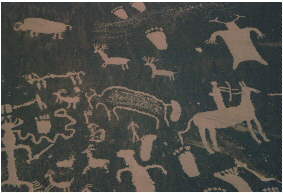
|
Rock art falls into two basic techniques, painting and pecking. These techniques are not only true for the Southwest of the United States of America but also for the rest of the world. In literature, the pictures or better the "engravings" which are made by pecking into the sandstone cliff are referred to as petroglyphs, while the pictures painted onto the stone cliffs are referred to as pictographs. Throughout the Southwest, pictographs can be found in a slightly greater abundance. They are usually painted in sheltered locations such as a cave or shallow overhang where the effect of erosion through wind, water and sun is minimal or non-existing. Painting was probably preferred to pecking because it took less time and labour to paint a picture than to peck it. In addition to that, painting also allowed greater details and a bigger variety of colours because different coloured clay was present all over the Southwest. These colours were mostly of mineral and vegetable origin. Blood and egg-white were probably used as a binder. Pecking was done either with a pointed stone of a harder consistency than the surface to be pecked, or where fine detail was required, indirectly with a hammer stone and pointed chisel-stone. The motives the Anasazi used are of great variety and beauty, like everything else of their culture, thus rousing my interest in a topic like the one of my essay. |
